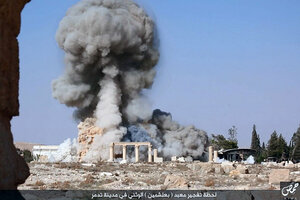ISIS destroys 2,000-year-old temple in Syria
The Islamic State released images that appear to show the destruction of the Baalshamin temple in Palmyra, Syria.

This undated photo released Tuesday, Aug. 25, 2015 on a social media site used by Islamic State militants, which has been verified and is consistent with other AP reporting, shows smoke from the detonation of the 2,000-year-old temple of Baalshamin in Syria's ancient caravan city of Palmyra. Arabic at bottom reads, "The moment of detonation of the pagan Baalshamin temple in the city of Palmyra."
Islamic State social media account/AP
Beirut
The Islamic State group released propaganda images Tuesday that purport to show militants laying explosives in and then blowing up the 2,000-year-old temple of Baalshamin in Syria's ancient caravan city of Palmyra.
The images, posted on social media by supporters of the group, showed militants carrying barrels of explosives and laying them inside the temple. Other, smaller wired cans lay around the temple walls and columns. Another image shows a grey plume of smoke rising above the temple from a distance, followed by an image of the temple reduced to a pile of rocks. One caption reads: "The complete destruction of the pagan Baalshamin temple."
The Associated Press could not independently verify the images. However, they were released like other group propaganda and carried a logo ISIS often used in the city of Palmyra, in Syria's central Homs province.
The images also corresponded to prior AP reporting. A resident of Palmyra had told the AP the temple was destroyed on Sunday, a month after the group's militants booby-trapped it with explosives.
The UN cultural agency UNESCO on Monday called the destruction of the temple a war crime.
Irina Bokova, the Unesco chief, said in a statement: “This destruction is a new war crime and an immense loss for the Syrian people and for humanity. Daesh (Isis) is killing people and destroying sites, but cannot silence history and will ultimately fail to erase this great culture from the memory of the world.
The temple, a structure of giant stone blocks several stories high fronted by six towering columns, was dedicated to a god of storm and rain — the name means literally "Lord of the Heavens." It was part of a sprawling Roman-era complex that includes other remains of temples to local gods and goddesses, including the even larger and slightly older Temple of Bel. Experts and residents fear the group will destroy the other ruins.
The Islamic State group, which has imposed a violent interpretation of Islamic law across its self-declared "caliphate" straddling Syria and Iraq, says such ancient relics promote idolatry. It already has blown up several sites in neighboring Iraq, and it is also believed to sell looted antiquities.
The group seized control of Palmyra, in the central deserts of Syria, in May.

